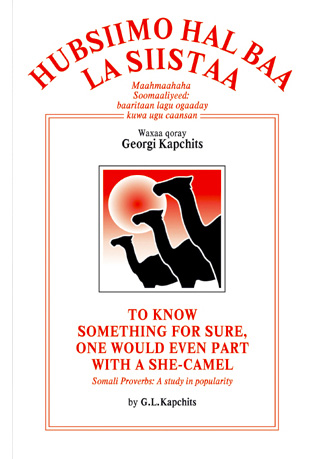
Mareegta Far-Shaxan

 |
Mareegta Far-Shaxan |
 |
| ha moogaan mareegta u ban baxday raadraaca taariikhda, dhaqanka iyo hidaha |
| Tifatirayaasha Farshaxan way ka madax banaan yihiin fikradaha gaarka ah ee ku sugan halkan |

|
Moscow, The Way Publishers, 2002 The list of the best known proverbs can be established by means of a special experiment,
the theoretical grounds and methods of which have been elaborated by the outstanding
Russian folklorist Grigory Permyakov . The Somali paremiological experiment, sponsored by The German Research Society),
was accomplished by the author in Berlin (under the auspices of the Humboldt University)
in 1999 and the Free University in 2000. 1000 proverbs formed the experimental corpus, or the list of proverbs for the questionnaires
which were to be distributed among some members of the Somali community in Berlin. But before
this was done, it was necessary to take one more step – to eliminate from every proverb the words
which were beyond the limits of its first modelling part, that is, to leave in the questionnaires
only the beginnings of proverbs:
Then ask the respondents to add the missing endings.
This method of testing, allows those proverbs to be revealed which are actively used in
contemporary culture. Thorough analysis of the data from 45 questionnaires has allowed the establishment of 249 proverbs
actively known by the majority (from 51.17% to 100%) of the informants. And it is the search for
these generally known paremias that was the main goal of the experiment. Some examples are given
here: Each text is cited in Somali, with English translation and where necessary an explanatory comment.
An Introduction presents the aims and procedures of the experiment,
the principles of the logico-semiotic classification and an analysis of
the literary features of Somali proverbs. The appendices offer rich proverbial
material for further folkloristic, philological and socio-linguistic research.
|
waxa nasiib leh qofkii buugan hanitidiise ku daree, toloow sidee lagu helayee Alla hawl yaraa guji xidhiidh
Buugaagtan si aad u dalbato la xidhiidh Dr. G. Kapchits'Email.